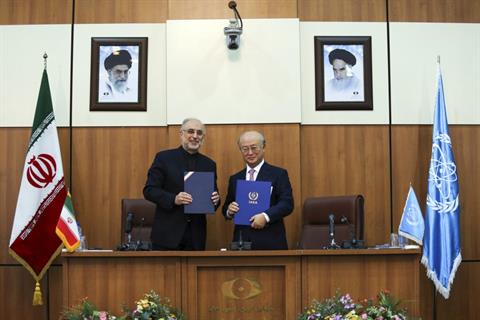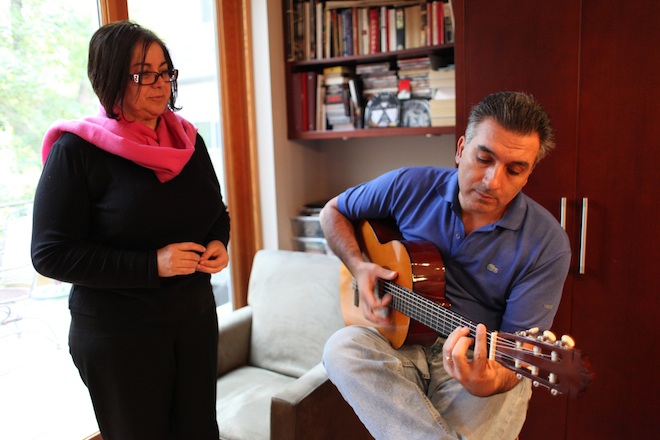November 15-2013

Iran and the International Atomic Energy Agency (IAEA) signed a very fuzzy and incomplete agreement Monday designed to improve their testy relationship.
But the short agreement was completely silent on the hottest point of friction—the IAEA’s access to the Parchin military base to look at a site where Iran is believed to have conducted work on a nuclear trigger a decade ago,
The absence of any mention of Parchin raised red flags for many critics looking at the agreement.
The agreement said the IAEA would gain “managed access” to the Gachine uranium mine near Bandar Abbas, but said nothing about the Saghand uranium mine in Yazd province.
It also said the IAEA would gain “managed access” to the heavy water plant being built at Arak, a plant that will produce plutonium that can be used to make bombs.
The agreement did not define “managed access” but The New York Times said the IAEA told it the phrase was used by the agency to refer to ground rules for inspections that allow a country to protect information, like military technology, it considers secret.
The agreement also said Iran would provide the IAEA with “mutually agreed relevant information” about Gachine and Arak. Critics pointed out that this meant Iran would give the IAEA information that Iran was willing to give, which provided the IAEA no guarantee of anything. “That is no change from what has been true for years,” one critic said.
The agreement also said Iran would provide “clarification” about its plans to build more enrichment plants and Iran’s interest in laser enrichment of uranium—both of which the Big Six are understood to want halted, not clarified.
And the agreement said Iran would be “providing information” on new planned research reactors and on the 16 sites Iran has designated for future nuclear power plants. But it did not say when full information would be provided. Iran is already obligated to give the IAEA such information. But the IAEA says the information must be provided as soon as Iran makes a decision on construction while Iran says it doesn’t have to say anything at all until construction is almost finished. Iran now says it will provide some, undefined, quantity of information. It did not agree that it has to provide full information when it decides on a nuclear project.
The only thing concrete in the agreement was that Iran pledged to provide the promised “managed access,” “clarifications” and “mutually agreed relevant information” no later than February 11, 2014, or within 90 days.
The IAEA has been trying to track down just what Iran has been doing in its nuclear program since the Islamic Republic revived it in 1985, in order to answer questions about possible military aspects of the program. To do that, the IAEA has been seeking access to people, places and paper—people who were involved in the program years ago; places, like Parchin, where the IAEA suspects weapons work was done; and paper, meaning documents dating back to 1985.
Monday’s brief agreement is totally silent on all that apart from the bland sentence: “Iran and the IAEA will cooperate further with respect to verification activities to be undertaken by the IAEA to resolve all present and past issues.” In other words, Iran promised to continue to discuss the issues that have been outstanding for a decade now.
To critics, this was just new evidence that the Rohani Administration hasn’t changed the previous policy of stringing out its interlocutors and playing for time.
The agreement was signed in Tehran after a few hours of talks between Yukiya Amano, the IAEA director general, and Ali-Akbar Salehi, the head of the Atomic Energy Organization of Iran.
Salehi told a news conference, “The Joint Statement that was signed today represents a road map that specifies bilateral steps in relation to resolving outstanding issues.” But that was difficult to see given that the Joint Statement was silent on so many issues, such as Parchin.
Salehi’s office announced last Tuesday that Amano would visit Iran this week. But Amano’s office immediately said he had not decided whether to go. It was only on Friday that the IAEA said Amano would go—one more example of the Islamic Republic conflating a proposal it has made with the agreement of others.
After returning to Vienna amid growing criticism, Amano emphasized that the agreement is only a starting point and that the numerous issues not addressed in this week’s agreement “will be addressed in subsequent steps.” Iran and the IAEA are to meet again December 11.
The Associated Press said the access to Arak “is perhaps the central concession” made by Iran. But under Iran’s previous definition of its requirements, it would be giving the IAEA access to the site in the first half of next year, so it was not much of a concession. In fact, since it need not give access under the new agreement until February 11, it might not be any concession at all.
























